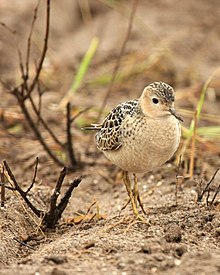Grass runners
| Grass runners | ||||||||||
|---|---|---|---|---|---|---|---|---|---|---|

Grass creeper ( Calidris subruficollis ) |
||||||||||
| Systematics | ||||||||||
|
||||||||||
| Scientific name | ||||||||||
| Calidris subruficollis | ||||||||||
| ( Vieillot , 1819) |
The Buff-breasted Sandpiper ( Calidris subruficollis , Syn. : Tryngites subruficollis ) is a small shorebird that in North America occurs and is a rare Irrgast , so an exception in Europe . It is most commonly observed in Great Britain, where a total of 680 individuals met between 1958 and 1982. These are mostly young birds that have drifted there in early autumn. It was observed a total of eighteen times in Germany between 1977 and 1997.
features
The grass runner reaches a body length of 18 to 20 centimeters. The wingspan is 43 to 48 centimeters. The weight varies between 55 and 75 grams.
The grass runner has sand-colored plumage. The dorsal plumage is significantly darker and has dark spots. The dark eye, which stands out clearly from the light plumage, is striking. The legs are orange-yellow. The beak is dark. It is noticeable that the species lifts its feet high when walking. Take-off is usually low above the ground. Also running fast while foraging. The distance to flee to people is often very short, and when worried they often assume a rigid posture at first.
Way of life
The Buff-breasted Sandpiper breeds in with grass -covered plains of the tundra of northern North America. He is a long-distance migrant who moves across central North America to southern South America . Its main wintering area is in Argentina . Overall, the winter quarters extend over the center of South America and extend from southern Bolivia to northern Argentina. During the passage it can be found on dry grass, pastures, short-grass prairies, golf courses, airports, sewage fields and fallow fields.
The grass runner is regularly observed as a so-called irregular visitor in Europe, mostly in Great Britain. Here especially in Scotland and Ireland. Occasionally it even occurs in small schools in Europe.
The grass walker likes to stay in freshly plowed fields. He is relatively trusting towards humans and can be observed outside the breeding season, for example on golf courses or airfields. Its food is insects . The grass scraper breeds on the ground. A clutch comprises an average of four eggs.
The stock was very low at the beginning of the 20th century. However, it has now stabilized and is listed by the IUCN as low risk.
supporting documents
literature
- Jonathan Alderfer (Ed.): Complete Birds of North America , National Geographic, Washington DC 2006, ISBN 0-7922-4175-4
- Hayman, Peter; Marchant, John & Prater, Tony (1986): Shorebirds: an identification guide to the waders of the world . Houghton Mifflin, Boston, ISBN 0-395-60237-8
- Richard Sale: A Complete Guide to Arctic Wildlife. Christopher Helm, London 2006, ISBN 0-7136-7039-8 .
Web links
- Calidris subruficollis in the endangered Red List species the IUCN 2008. Posted by: BirdLife International, 2008. Accessed on 7 November, 2008.
- Photo of a grass walker
Single receipts
- ↑ Buff-breasted Sandpiper ( Calidris subruficollis ) at HBW Alive
- ↑ Hans-Günther Bauer, Einhard Bezzel and Wolfgang Fiedler (eds.): The compendium of birds in Central Europe: Everything about biology, endangerment and protection. Volume 1: Nonpasseriformes - non-sparrow birds , Aula-Verlag Wiebelsheim, Wiesbaden 2005, ISBN 3-89104-647-2 , p. 523
- ↑ Sale, p. 199
